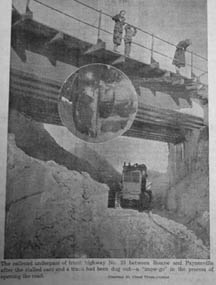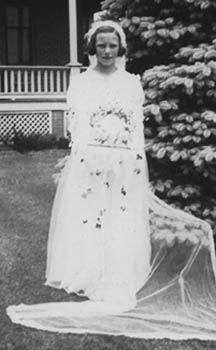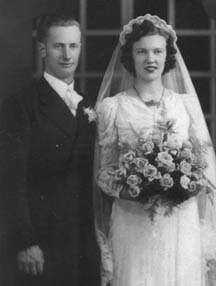 Osendorf likely has covered the 100 feet between the house and the barn tens, maybe hundreds of thousands of times since tragedy struck on that familiar stretch in 1940.
Osendorf likely has covered the 100 feet between the house and the barn tens, maybe hundreds of thousands of times since tragedy struck on that familiar stretch in 1940.Dairy farmers make at least two return trips to the barn each day, usually several more.
Resorting to estimation, figure a half dozen crossings a day, hundreds a month, and thousands a year.
 Osendorf likely has covered the 100 feet between the house and the barn tens, maybe hundreds of thousands of times since tragedy struck on that familiar stretch in 1940.
Osendorf likely has covered the 100 feet between the house and the barn tens, maybe hundreds of thousands of times since tragedy struck on that familiar stretch in 1940.
Sixty years ago, what's regarded as the worst storm in Minnesota history prevented Norbert's oldest sister from making that familiar walk safely. "It's not very far, but in a snowstorm it's a long ways," said Norbert.
Della, 13 years old at the time, was the only local fatality in the great Armistice Day Blizzard of 1940.
Throughout the state, the storm claimed 59 lives, according to a book about the event by William H. Hull. The Twin Cities received 16 inches of snow, but Collegeville reported almost 27 inches.
During the Armistice Day Blizzard of 1940, 26 inches of snow were reported at Collegeville. Enough snow fell and blew around Paynesville to completely plug this underpass on Highway 23.
Norbert, who was six at that time, wasn't old enough to experience much of the storm, but from what he has heard he knows that most Minnesotans today have never experienced a blizzard of that magnitude. "There's a lot of people who don't know what a snowstorm is," said Norbert.
The last storm that was close was in 1975, he said, which was the only time that he and his wife, Betty, were prevented from walking to the barn for chores. During that storm, they waited for daylight and held hands while walking to the barn. That storm, according to Norbert, "was nothing like the one (in 1940) it sounds to me."
The storm
Armistice Day, now known as Veteran's Day, originated from the end of the First World War in 1918, when hostilities were ceased on the 11th hour of the 11th day of the 11th month. That's 11 a.m. on Nov. 11. After World War II, the day was changed to Veteran's Day to recognize all veterans, but in 1940 it was still known as Armistice Day.
The fall in November had been relatively mild. Many farmers still had chickens and pigs grazing free range around their farms. Their unsheltered state led to a number of livestock casualties.
Sunday, Nov. 10, was mild, with many hunters out looking for deer and ducks. People had no inkling of what was to come, and were caught by surprise and off-guard by the storm that ensued.
"The trees all had their leaves on, so it wasn't cold. It was nice weather before that," said John Mike Mehr, who had his wedding delayed by the storm.
Snow started on Sunday night. "It was snowing real quiet," said Norbert. Just coming straight down. No wind at all."
On Monday, the winds reached 60 miles per hour.
The open gate
 Della and her father headed to the barn together to do afternoon chores. At that time, electricity had not reached the country around Roscoe, so the barn was dark. His father and sister probably carried lanterns, but these would blow out in the storm and have to be relit at the barn.
Della and her father headed to the barn together to do afternoon chores. At that time, electricity had not reached the country around Roscoe, so the barn was dark. His father and sister probably carried lanterns, but these would blow out in the storm and have to be relit at the barn.
Della Osendorf, shown right, posed before a wedding. The 13-year-old Roscoe girl was one of 59 fatalities in the state.
On the way to the barn, Della and her father were separated. When Della arrived, her father was no longer behind her, so she walked back to the house and shouted at her mother, who asked her to stay.
But Della went looking for her dad, and wasn't seen alive again. The storm was so fierce that her body wasn't found for a full day, until Tuesday afternoon.
Her father had gone off course on his way to the barn, according to Norbert, but had run into some corn stacks next to the barn. From these, he knew where he was and made it to the barn, only after Della had returned to the house.
He started to search for Della, but if it's hard to find a stationary object as familiar and large as a dairy barn, you can imagine the difficulty in finding a lost person. "How much looking could you do in a snowstorm?" Norbert asked. "You might not have made it back."
"They claimed that you couldn't see," he added. "They claim that snow stuck to your face and you couldn't see."
By Tuesday, some neighbors had been notified and had come to help search. Norbert's grandparents came by horse to help look.
The storm buried the corn stacks in six feet of snow. For a time, they feared that Della might have been buried between the stacks.
Before they dug the snow out from the stacks, though, two neighbors found her body in a field, about 100 yards from the barn.
Somehow, Della must have walked through the gate in the fence and out in the field without noticing.
The storm was so powerful that breathing was difficult. That's one thing that Betty remembers her father telling her about the blizzard.
"She was facing the wind," said Norbert. "She was headed west." His belief is that facing the wind, Della couldn't breath and collapsed in the snow. Later she suffocated.
"After they found her, they couldn't get her to Roscoe," Norbert said. "The hill was shut."
"Our driveway was open, but the road to Roscoe I guess that was just blocked solid," he added.
The massive snowfall and the wind led to huge drifts. Several underpasses, including on Highway 23 between Paynesville and Roscoe, were filled with snow and had to be dug out.
Wait a week to marry
Mehr, who lives seven miles north of Paynesville on County Road 33, within a few miles of St. Martin, went into town for a doctor's appointment that Monday morning. He expected to be home before it got bad. He was scheduled to marry Leona Miller in Spring Hill.
 Mehr got two miles from Paynesville before he ran off the road due to the lack of visibility. Then he and his sister had to walk across 40 acres to a nearby farm house. "It was walking tough," recalled Mehr. "The wind was pretty strong by then."
Mehr got two miles from Paynesville before he ran off the road due to the lack of visibility. Then he and his sister had to walk across 40 acres to a nearby farm house. "It was walking tough," recalled Mehr. "The wind was pretty strong by then."
John Mike and Leona Mehr, shown right, pose for a wedding picture on Nov. 18, 1940. They were supposed to be married on Nov. 11, but the storm stranded John Mike an delayed their wedding for a week.
They ended up stranded on that farm for two days, and didn't walk home until Wednesday, after the storm had passed. There were no telephones in those days, so Mehr had no way to contact Leona, who lived on a farm three miles east of Spring Hill. She wasn't surprised when he didn't come as planned.
"My mother said right away that nobody would come," she explained. That no one did is about the only thing she remembers from the storm. She does recall the teasing she got afterwards.
In those days, winter weddings were frequently held on Monday, because the church was still warm from Sunday. So John Mike and Leona were married a week after the storm, on Nov. 18, 1940. A winter storm won't delay the celebration of their 60th anniversary. They've celebrated in advance.